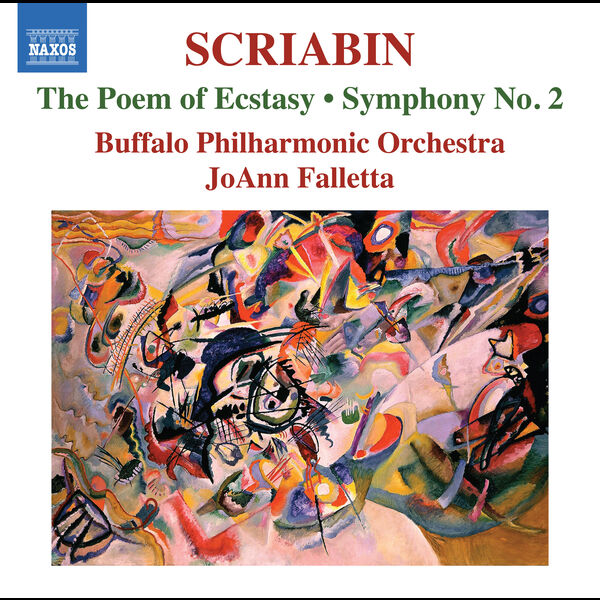
Buffalo Philharmonic Orchestra, JoAnn Falletta – Scriabin: Symphony No. 4, Op. 54 “Poème de l’Extase” & Symphony No. 2 in C Minor, Op. 29 (2023)
FLAC (tracks) 24 bit/96 kHz | Time – 59:32 minutes | 1,10 GB | Genre: Classical
Studio Masters, Official Digital Download | Digital Booklet, Front Cover | © Naxos
Scriabin composed most of his single-movement fourth symphony The Poem of Ecstasy between 1905 and 1908 in Italy and France. He originally intended it to be called Poème orgiaque (‘Orgiastic Poem’) with its unprecedented raw sensuality and overpowering aesthetic, taking chromaticism beyond even Wagnerian voluptuousness. His earlier Symphony No. 2 in C minor adopts César Franck’s cyclical ideas to which Scriabin layered sweeping climaxes, majestic intensity and rich orchestral colour that enliven its five movements with ceaseless invention.Alexander Scriabin is one of those fascinating historical figures whose unorthodox beliefs about music and life continue to generate controversy. He was given to making brazenly outrageous pronouncements, and once described the music of Igor Stravinsky as ‘a mass of insolence and a minimum of creative power.’ Half a century later he himself was taken down a peg or two by Wilfrid Mellers, who memorably wrote that ‘Scriabin whipping himself into ecstasy is not so different from that other cosmopolitan Russian, Tchaikovsky, whipping himself into fury or despair: except that Scriabin’s melodic vitality is so much lower.’ The use of the word ‘vitality’ is interesting because Scriabin always attached great psychological importance to the idea of artistic and physical potency. According to the musicologist Leonid Sabaneyev (a former colleague of the composer) Scriabin inextricably linked the creative act with the sexual and maintained that maximum creative power is inseparable from maximum eroticism. He even claimed that it was a decrease in sexual vitality in the ageing Wagner that accounts for the stylistic differences between Tristan and Parsifal.
At an age when he would still have considered his own vitality to be wholly undiminished, Scriabin succumbed to fatal septicaemia caused by an abscess on his lip. He was only 43. His unrealised projects included his magnum opus: an ambitious sacred theatre piece called Mysterium, which was envisaged as ‘the act of union between the Male-Creator and the Woman-World’. It was intended to be a transformative event for all humanity, and members of the audience were to indulge in passionate behaviour if they felt so moved. Scriabin aimed to produce it over the course of seven days and seven nights in the Himalayas, and he even went so far as to acquire a plot of land in Darjeeling for this purpose.
The Poem of Ecstasy may be somewhat tamer than Mysterium, but as Martin Cooper has observed, there is still ‘plenty of internal evidence to suggest erotic connotations.’ Indeed, there is no escaping the unmistakable nature of erotic fantasy implied by such musical directions as ‘avec une volupté de plus en plus extatique’ which, if fully observed, propel the piece almost literally towards an ineffable release of delayed gratification redolent of the yearning of Tristan and Isolde. …
Tracklist:
1-01. Buffalo Philharmonic Orchestra – Symphony No. 4, Op. 54 “Poème de l’Extase” (19:16)
1-02. Buffalo Philharmonic Orchestra – Symphony No. 2 in C minor, Op. 29: I. Andante – (06:29)
1-03. Buffalo Philharmonic Orchestra – Symphony No. 2 in C minor, Op. 29: II. Allegro (09:15)
1-04. Buffalo Philharmonic Orchestra – Symphony No. 2 in C minor, Op. 29: III. Andante (10:52)
1-05. Buffalo Philharmonic Orchestra – Symphony No. 2 in C minor, Op. 29: IV. Tempestoso – (05:54)
1-06. Buffalo Philharmonic Orchestra – Symphony No. 2 in C minor, Op. 29: V. Maestoso (07:43)
Download:
mqs.link_Buffal0Philharm0nic0rchestraJ0AnnFallettaScriabinSymph0nyN0.40p.54P0medelExtase20232496




















![Jacek Muzyk, Daniel Kerdelewicz, Buffalo Philharmonic Orchestra, JoAnn Falletta - The Golden Age of the Horn - Concertos for 2 Horns (2024) [FLAC 24bit/96kHz] Jacek Muzyk, Daniel Kerdelewicz, Buffalo Philharmonic Orchestra, JoAnn Falletta - The Golden Age of the Horn - Concertos for 2 Horns (2024) [FLAC 24bit/96kHz]](https://imghd.xyz/images/2024/10/24/jt622hsiwrr9a_600.jpg)
![Amy Porter, Nikki Chooi, Buffalo Philharmonic Orchestra, JoAnn Falletta - Lukas Foss: Symphony No. 1 & Renaissance Concerto (2024) [FLAC 24bit/96kHz] Amy Porter, Nikki Chooi, Buffalo Philharmonic Orchestra, JoAnn Falletta - Lukas Foss: Symphony No. 1 & Renaissance Concerto (2024) [FLAC 24bit/96kHz]](https://imghd.xyz/images/2024/05/23/s2r366rrnoixc_600.jpg)
![Buffalo Philharmonic Orchestra & JoAnn Falletta - Ellington: Black, Brown and Beige (2013/2015) [FLAC 24bit/192kHz] Buffalo Philharmonic Orchestra & JoAnn Falletta - Ellington: Black, Brown and Beige (2013/2015) [FLAC 24bit/192kHz]](https://getimg.link/images/imgimgimg/uploads/2020/02/ZQy9mqk.jpg)
![Michael Ludwig, Buffalo Philharmonic Orchestra, JoAnn Falletta - Corigliano: Violin Concerto, The Red Violin - Phantasmagoria (2010/2015) [FLAC 24bit/192kHz] Michael Ludwig, Buffalo Philharmonic Orchestra, JoAnn Falletta - Corigliano: Violin Concerto, The Red Violin - Phantasmagoria (2010/2015) [FLAC 24bit/192kHz]](https://getimg.link/images/imgimgimg/uploads/2020/02/axOZ2xk.jpg)
![JoAnn Falletta, Buffalo Philharmonic Orchestra - Schmitt - Orchestral Works (2020) [FLAC 24bit/96kHz] JoAnn Falletta, Buffalo Philharmonic Orchestra - Schmitt - Orchestral Works (2020) [FLAC 24bit/96kHz]](https://getimg.link/images/imgimgimg/uploads/2021/03/lFG7QHq.jpg)
![Anna Mattix, Timothy McAllister, National Orchestral Institute Philharmonic, JoAnn Falletta - Copland, Creston & Others: Orchestral Works (2023) [FLAC 24bit/96kHz] Anna Mattix, Timothy McAllister, National Orchestral Institute Philharmonic, JoAnn Falletta - Copland, Creston & Others: Orchestral Works (2023) [FLAC 24bit/96kHz]](https://imghd.xyz/images/2023/12/07/kwellqmmgypmb_600.jpg)
![Danny Elfman, Royal Liverpool Philharmonic Orchestra, JoAnn Falletta - Percussion Concerto & Wunderkammer (2024) [FLAC 24bit/96kHz] Danny Elfman, Royal Liverpool Philharmonic Orchestra, JoAnn Falletta - Percussion Concerto & Wunderkammer (2024) [FLAC 24bit/96kHz]](https://imghd.xyz/images/2024/05/17/nn68gbfn79s5a_600.jpg)
![JoAnn Falletta & Alain Lefevre - Mathieu: Concerto No. 3 / Gershwin: An American in Paris (2017) [Qobuz FLAC 24bit/96kHz] JoAnn Falletta & Alain Lefevre - Mathieu: Concerto No. 3 / Gershwin: An American in Paris (2017) [Qobuz FLAC 24bit/96kHz]](https://getimg.link/images/imgimgimg/uploads/2018/07/DaLWpnW.jpg)
![Buffalo Philharmonic Orchestra, JoAnn Falletta - R. Strauss: Le bourgeois gentilhomme Suite & Ariadne auf Naxos, Symphony-suite (2017) [FLAC 24bit/96kHz] Buffalo Philharmonic Orchestra, JoAnn Falletta - R. Strauss: Le bourgeois gentilhomme Suite & Ariadne auf Naxos, Symphony-suite (2017) [FLAC 24bit/96kHz]](https://getimg.link/images/imgimgimg/uploads/2020/06/fCoQfnu.jpg)
![Ulster Orchestra & JoAnn Falletta - Paine: Symphony No. 2 - Oedipus Tyrannus: Prelude (2015) [FLAC 24bit/192kHz] Ulster Orchestra & JoAnn Falletta - Paine: Symphony No. 2 - Oedipus Tyrannus: Prelude (2015) [FLAC 24bit/192kHz]](https://getimg.link/images/imgimgimg/uploads/2020/03/RM5kE4i.jpg)